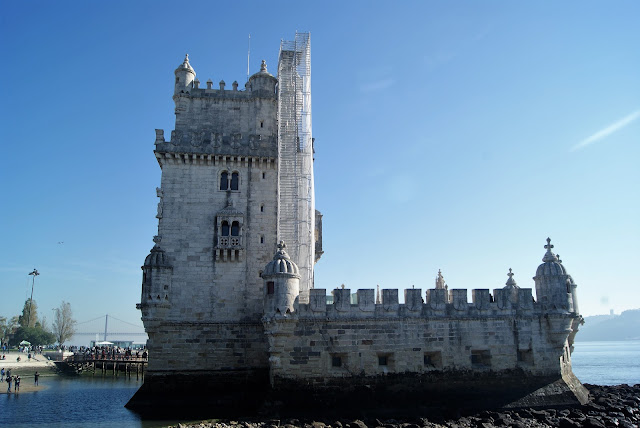Previously in Part 2, I visited Sintra, and Cabo Da Roca, which is the westernmost end of continental Europe. Check it out at:
https://weesertan.blogspot.com/2021/02/lisbon-part-2-sintra-and-cabo-da-roca.html
On Day 3, I visited the historical riverfront of Belem, by the River Tagus.
 |
| Any Malaysian history text book would teach that in 1511, the Portuguese came on shore at Malacca, and they departed from here - The River Tagus |
~~~
As usual, I would leave my hostel by 10am after enjoying a nice breakfast. Taking the 15E tram, I headed westward to Belem, and the first port of call was for more breakfast.
 |
| In search of the original Portuguese egg tarts |
 |
| In hindsight, I may have just skip the hostel's breakfast |
 |
| Looks like Malaysian food has got some influence from Portugal (Popiah, famosa, cucuk udang) |
 |
| An analogue cashier! Selling pastries must have been quite lucrative |
 |
| Pastries right from the oven to your table |
I am happy to have egg tarts under the sun
Though not a fan, I have been eating egg tarts for ages, from places like Macao and Hong Kong. The egg tarts of Belem have crispy outer layer, and very thick egg paste. It wasn't sweet, so it was something I am pleased with.
In other words, this is like the final 'petrol station' before you start your road trip
The then King Manuel funded the church by incurring a 5% tax on commerce from Africa and Asia (around 70Kg of gold) annually
Impressive architecture, as always
Pardon my then phone camera - HTC E9's resolution
Malaysians of my generation (Gen-Y) would study about the Malacca Sultanate and the foreign colonial powers that came. We learned that Vasco da Gama (1468-1524) was the first European to reach Asia (Kerala in India), while Afonso de Albuquerque (1453-1515) came to Malacca and then China.
Nice to meet you. I work as a navigator - what a career!
Sir, you have my utmost respect
Not far away is the tomb of Camoes. To be honest, I haven't heard about this person, but the description tells everything - One of the greatest Portuguese writer.
You can have amazing adventures, but you need someone to record and note them down, painstakingly
I suppose there's a reason why you earn to rest here for eternal
The Spanish meanwhile, sailed west to discover America
The world was subsequently divided into two halves. The Spanish controlled the sea routes covering the Philippines to Latin America (except Brazil). The Portuguese would control the eastward sea lines from Europe to Asia. The Dutch, British came a century or two later.
If the Jeronimos Monastery was the final 'petrol station', the Tower of Belem would be the last 'checkpoint'.
Since the 14th century, it acted as a fort and a ceremonial gateway to Lisbon
King Manuel, wherever you are, thank you for exploration of the world - and introducing 'globalization'
The benefits of visiting during low season (winter) - The crowd was manageable
There was no doubt why British tourists flock to the Iberian Peninsular for their winter break - Escaping the (hopeless) weather and topping up Vitamin D!
Afonso de Albuquerque stands tall in a garden nearby
Lunch was nothing Portuguese - The baguette was fresh and delicious though
I got back to Lisbon central and explored the neighborhood of Alfama, the oldest in Lisbon. The name itself is un-Portuguese, but Arabic, coined during the Moorish days (6th century).
Narrow alleys, historical sites
As usual, more hiking (as you are in Lisbon). But more hiking comes with some of the most spectacular views in Lisbon.
Miradouro Graca viewpoint
Be rest assured that every corner is picturesque in Lisbon
Had dinner with my new found friend near my hostel, and it was superb.
Can't remember why we ordered this
Spicy seafood soup - The octopus was juicy and meaty, absolutely splendid
With a full stomach, I decided to hike up the terrace behind my hostel.
Castle of Sao Jorge
It was quite an amazing day, where history, architecture and spectacular views converged. The suburb of Belem and Alfama exceeded my expectations. I would visit again, anytime.
To be continued...


























Nice post! Your travel experiences of Portugal in Alfama & Belem have certainly caught my attention. I would love to apply for a Portugal Visa Appointment, clear the formalities and get my visa soon so that I can explore some of the most popular attractions of Portugal. I heard that Portugal is famous for its gastronomical delights. So, I will be giving those a try too.
ReplyDelete